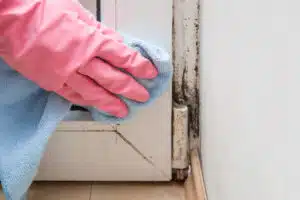Despite the fact that most of us focus on keeping our rugs vacuumed and our shelves dusted, windows can often be one of the dirtiest parts of your house—but not for long.
Cleaning your windows may sound daunting, but the process is actually quite simple if you know what you’re doing.
Take a deep breath, grab your favorite cleaning spray, and read on for the best ways to clean windows as well as tips, tricks, and product recommendations.
What method is best for cleaning windows?
There’s no one right way to clean your windows, but with the following tips, you’ll be on your way to streak-free windows in no time.
What to clean windows with:
All windows should be cleaned with a brand-name commercial cleaner or an at-home vinegar or soap solution. If you’re going the brand-name route, your favorite brand is likely A-okay. We also recommend Spic & Span Cinch Glass Cleaner, Invisible Glass, or trusty old Windex.
How to make a vinegar solution to clean your windows
If you’re going the DIY-route, a vinegar solution is one way to go. All you’ll need is:
- White vinegar (don’t use apple cider vinegar or white wine vinegar!)
- Water
- An empty spray bottle or bowl
- Essential oils (optional)
Simply mix 1 part white vinegar with 2 parts water. You can put the solution in a spray bottle or mix it up in a small bowl and dip your cleaning cloth into it. A few drops of essential oils will help it smell nicer before the vinegar scent dissipates.
How to make a soap solution to clean your windows
For a DIY soap solution, you’ll need to gather up:
- Dish soap (such as Dawn, Ajax, or Palmolive)
- Water
- An empty spray bottle or bucket
Since dish soap gets very sudsy very easily, be sure to get the ratio correct! In general, you can use about 2 gallons of water to 1 teaspoon of dish soap.
If you’re ready to go the extra mile, you can also combine the two methods for a vinegar and dish soap solution. In this case, you’ll simply combine 2 cups of water, ¼ cup white vinegar, and a few drops of dish soap in a spray bottle, and—voila! You’ve harnessed the cleaning power of both.
It’s important to note, however, that DIY isn’t the best solution for everyone. If your city or town uses hard water, that means your tap water is full of minerals like calcium and sodium. Those minerals might be fine for drinking water, but they’re not ideal for cleaning and can leave streaks and white spots on your glass. Over the long term, windows may start to look foggy and sustain damage. Check your local water designation online. If your community uses hard water, opt for the store-bought cleaner.
How often should you clean your windows?
You should clean your windows whenever they get dirty. There’s no hard and fast rule about how long you should go between window cleanings, but if you can see the grime, give them a wash. As long as you’re using non-corrosive cleaners, you won’t do any damage to the windows by cleaning frequently. Similarly, don’t stress about going too long in between cleans. If you live in an area with extreme weather, your windows can wait for the right day.
How to prepare your windows for cleaning.
Before you start spraying, make sure you prepare your windows for the cleaning process. There are two major window cleaning preparation steps:
- Remove any non-window elements: Curtains, blinds, and other window dressings can get in the way of a streak-free clean. They often get dirty as well and need their own sprucing, but that should always be done with those elements removed from the wall. Curtains especially attract dust like magnets. If you beat your curtains while they’re hanging, you’ll only send more dust onto your window glass and sill. Take them outside, then put them back on the wall after you finish cleaning.
- Dust your windows: Just as floors need to be swept before being mopped, windows need to be dusted before getting wiped down. This doesn’t need to be an intense process, but removing dry dust from your windows before washing them ensures that you don’t end up rubbing wet dust all over the glass. Just use a dry cloth or a small vacuum to get rid of cobwebs and debris before diving in.
What’s the best way to clean windows?
The best way to clean windows is with our simple, 13-step checklist you can repeat whenever you need. This isn’t the only way to clean windows, but if you need help getting started, we’ve got you covered.
What tools do I need to clean my windows?
Depending on the cleaning solution you’ve chosen, you’ll need the following:
- Your chosen liquid cleaning solution in a spray bottle or bucket (see above)
- Microfiber/lint-free cloths
- Small vacuum (optional)
- Sponge/sponge mop on a pole (optional)
- 8-10-inch squeegee (optional)
- Outside hose (optional)
How to clean the inside of windows.
To clean the inside of your windows, follow these 5 steps:
- Grab your cleaner (either DIY or commercial spray), a microfiber cloth or sponge, and a towel for any loose liquid drops.
- Use your cloth to dry-dust the window starting at the top and moving down in an S-shape to the bottom. If you have a lot of dust, use a small vacuum instead.
- Spray or sponge your cleaning solution all over the window. Use your towel to catch any drops before they hit the bottom.
- Using a clean cloth, wipe the solution across the window in the same top-down, S-shaped motion until the window is dry.
- Repeat until clean, streak-free, and shining.
That’s it! You can always go back in with a small bit of cleaner for any stubborn spots, but these five steps will leave the inside of your window looking good as new.
How to clean outside windows
To clean the outside of your windows, follow these 8 steps:
- Start with a rinse. Outside windows usually have far more dirt than inside windows, so it’s best to get ahead of the stubborn stains. If you have access to a hose, this is a great time to use it.
- Get your cleaning solution ready. For outside windows, DIY is often more cost effective than buying commercial cleaners.
- Use a clean cloth or sponge and wipe or spray your cleaning solution over the entire window. If you’re working with a large or tall window, you can also use a sponge mop on a pole.
- Rinse the entire window with a hose or wrung cloth.
- Apply either another dose of the water solution or a commercial cleaner to the entire window.
- Using a towel or a squeegee (for taller windows), wipe the new solution in an S-shape from top to bottom. Wring your towel or wipe your squeegee at the end of each line.
- Rinse and repeat until clean and streak-free.
- Make sure there are no water streaks on the window before letting it dry.
Depending on the window style, you might need additional steps or special tricks—if you’ve ever wondered how to clean a double-hung window, you understand. That said, this is a great start to streak-free window cleaning. Now, let’s take a look at a few more details.
Pro tip: It’s often better to clean windows on cool or overcast days. If the sun is shining, your window cleaning solution may dry too quickly, leaving you with streaks!
How to clean window screens
There are different techniques to clean window screens depending on whether your screen is removable.
Removable screens are always easier to deep clean because you can turn them on their side and let gravity help you out. Gather up:
- Lint-free cloth or small vacuum cleaner
- Cleaning solution in a spray bottle or bowl:
- ¼ cup vinegar mixed with ½ gallon water, or
- 1 teaspoon dish soap mixed with ½ gallon water
- Sponge
- Hose or bucket
Remove the screen from the window and take it outside. Do a basic dusting with a cloth or vacuum before cleaning. Using a sponge, scrub the solution into your screen and then hose it down or dump clean water on it to rinse. Just be sure to let removable screens dry fully before you put them back in their frame. Damp screens are a one-way ticket to hidden mold—and that’s the last thing you want.
Non-removable screens, however, present a trickier problem. You can’t always wash them without making a mess, so dry methods are often the best way to go. Lint rollers and small vacuum attachments are the tried and true champions of dry cleaning window screens. Just keep your pressure gentle so that you don’t tear the screen in the process.
How to clean window sills
If you’ve ever tried to clean your window sills, you’ve probably been shocked at how dirty they get. Open windows let in breezes, but they also let in small insects, dirt, and general outside debris—even with a screen. Over time, that dirt cakes onto your window sills and doesn’t come off without a fight.
Luckily, you can easily clean your window sills with the right tools. You’ll need:
- Lint-free cloths for dusting/scrubbing
- Vacuum cleaner (optional)
- Cleaning solution:
- General surfaces cleaner or
- DIY: A few drops of dish soap mixed with 2 cups water in a spray bottle
- DIY: For tough stains, you can make a paste by combining baking soda and a small amount of water and scrub with an old toothbrush
After dusting and/or vacuuming your window sill (again, always dust before using liquid cleaner), spray your cleaning solution onto a cloth and start scrubbing! For wooden window frames/sills in particular, it’s important not to spray liquid directly onto the frame. For tough stains, use a toothbrush to scrub your baking soda paste onto the dirty spot and wipe clean with a damp cloth.
How to clean mold from windows
You can clean small amounts of mold with standard window cleaner, but if you’re noticing mold on your windows, you might have bigger problems. Mold can pop up as a result of humidity or other household factors, but it can also be a telling sign of window damage letting in moisture.
Worried it may be black mold? Learn what may be causing it, as well as how to remove and prevent mold growth on windows.
Do I need a replacement window?
If you have large amounts of mold, especially between your window glass panes, it’s time to call in the experts. Mold problems can range from a simple fix to deep structural damage. If you’re worried, you can always reach out to the window replacement experts at Window Nation for a free consultation.
Still have questions? Call in the professionals.
Even with a great guide, window cleaning can still be a tricky beast. If you need help with window cleaning, replacing, or installation, Window Nation is here to help. Contact us anytime for expert window assistance.





